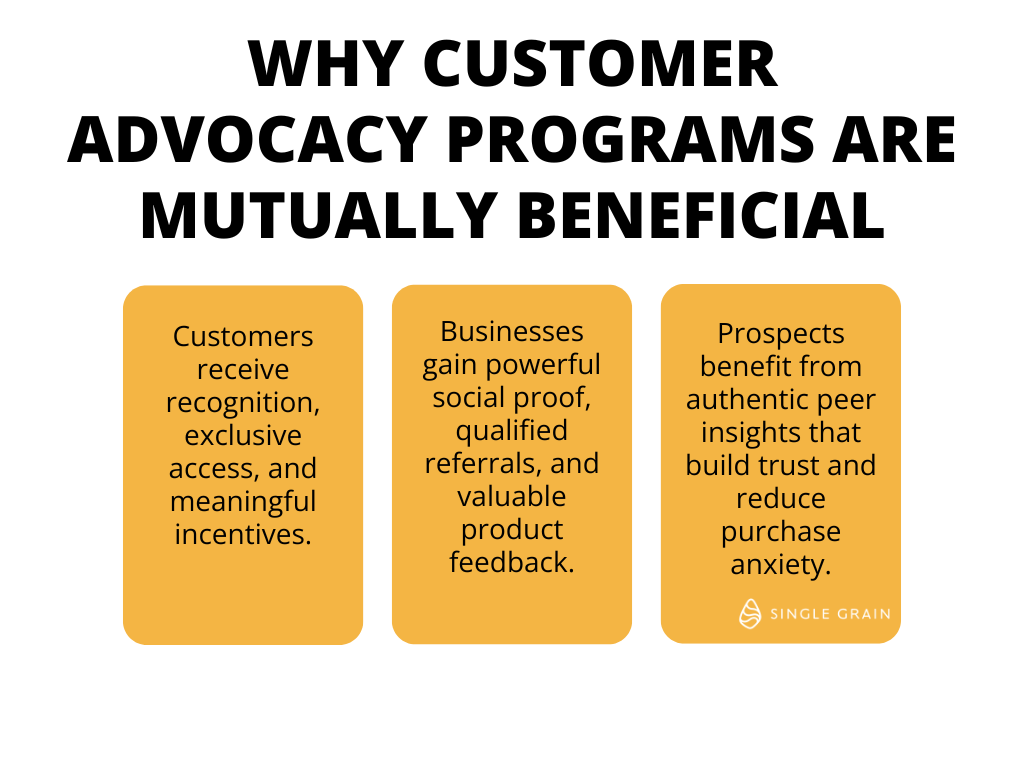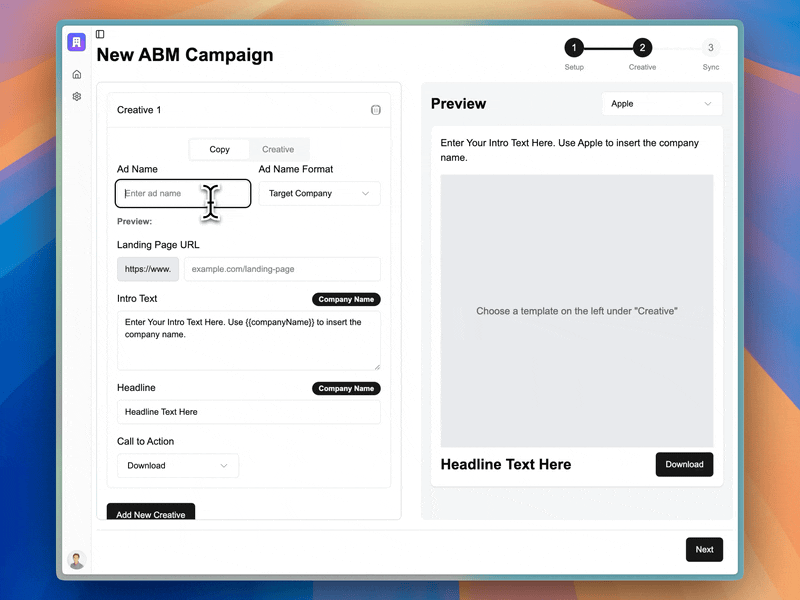Brands are constantly told that word-of-mouth marketing is the secret to revenue growth. But how can brands apply this concept to their marketing and advertising campaigns? Customer advocacy programs are the secret. This tactic still drives trust among consumers while enhancing brand presence and reputation.
More than half of today’s organizations have embraced a robust growth strategy that turns their most satisfied customers into revenue-generating assets. According to the Customer Marketing Alliance, 52.2% of organizations reported having a customer advocacy program in 2024. This number continues to climb as companies recognize the untapped potential of their existing customer base.
But what separates successful customer advocacy programs that generate significant revenue from those that merely collect testimonials? The difference lies in strategic implementation, cross-functional alignment, and technology integration—all backed by measurable results.
Whether you’re launching your first advocacy initiative or optimizing an existing program, this guide will provide the frameworks, metrics, and real-world examples you need to transform satisfied customers into powerful brand champions.
Key Takeaways
- Customer advocacy programs generate significant business value, with referral-based leads converting four times faster and having a 30% higher average value—meanwhile, advocate-generated content costs just one-tenth of traditional creation methods.
- Successful advocacy programs require three essential components, including strategic advocate identification based on data-driven metrics, meaningful value exchange mechanisms that address intrinsic motivations, and technology integration to scale personalization.
- Implementation follows a three-phase approach starting with foundation building (defining metrics and securing cross-functional buy-in), followed by a focused pilot with 20-30 engaged customers, and finally scaling with supporting technology and tiered engagement paths.
- The future of customer advocacy programs is shifting toward community-centric models where advocates connect with each other, predictive management using AI, and integrated experiences that embed advocacy throughout the customer journey.
- Even small advocacy initiatives can deliver measurable ROI when they track direct attribution through referral codes, separate conversion funnels for advocate-influenced opportunities, and cost savings from advocate-generated content.
What Are Customer Advocacy Programs?
Customer advocacy programs are groups where buyers recommend and promote a brand and their products to others. These programs not only prove customer loyalty but also engage a new audience, resulting in a healthy number of new leads going down the sales funnel. Unlike traditional marketing that pushes messages outward, these programs harness the genuine enthusiasm of your existing customer base to drive growth organically.

The most effective customer advocacy programs create a mutually beneficial relationship where:
- Customers receive recognition, exclusive access, and meaningful incentives.
- Businesses gain powerful social proof, qualified referrals, and valuable product feedback.
- Prospects benefit from authentic peer insights that build trust and reduce purchase anxiety.
This symbiotic dynamic explains why the customer advocacy software market is projected to grow at 9.1% CAGR from 2024 to 2032, according to Credence Research. Organizations are increasingly recognizing that formalized advocacy programs deliver a measurable business impact beyond traditional customer satisfaction initiatives.
To create a customer advocacy program, brands must identify satisfied customers to promote their brand through authentic recommendations, testimonials, case studies, and referrals.
Business Impact of Customer Advocacy Programs
The evidence supporting investment in customer advocacy programs continues to strengthen. These programs deliver substantial business value across multiple dimensions:
| Benefit Area | Impact Metrics |
|---|---|
| Sales Acceleration | Referral-based leads convert 4x faster with 30% higher average value |
| Marketing Efficiency | Advocates generate content at 1/10th the cost of traditional creation |
| Product Development | Advocate feedback reduces development cycles by up to 20% |
| Customer Support | Community-based support reduces ticket volume by 10-25% |
The sustainability of these programs is particularly noteworthy. According to Influitive, 95% of companies have observed an increase or stability in their number of customer advocates, demonstrating the enduring value of well-structured advocacy initiatives.
This explains why organizations that systematically leverage customer advocacy are seeing an advantage—they’re using loyal customers to effectively expand their marketing, sales, and product teams without proportional cost increases. All of this boosts customer acquisition, brand awareness, and overall business growth.
Essential Components of Successful Advocacy Programs
The most effective customer advocacy programs share several key elements that set them apart from casual reference programs or testimonials.
Identifying Key Customers
Rather than simply targeting all satisfied customers, successful programs use data-driven approaches to identify ideal advocates based on:
- Engagement metrics: Product usage patterns, feature adoption rates, and community participation.
- Satisfaction signals: NPS promoters, high CSAT scores, and positive sentiment in support interactions.
- Advocacy potential: Social media presence, professional credibility, and communication style.
This targeted approach ensures you’re investing in relationships with customers who have both the motivation and means to become effective advocates.
Value Exchange Mechanisms
Sustainable advocacy programs create clear value for participants beyond rewards. Consider structuring your value exchange around:
- Professional growth: Speaking opportunities, leadership visibility, and career development.
- Exclusive access: Early feature releases, executive interactions, and roadmap influence.
- Community connection: Peer networking, specialized events, and industry recognition.
- Monetary incentives: Only when aligned with authentic advocacy and regulatory guidelines.
The most compelling value propositions address advocates’ enthusiasm and motivations rather than relying solely on rewards.
Technology Integration
Modern advocacy programs leverage technology and data-driven techniques to scale personalization and management. Adobe reports that 73% of businesses in 2025 are using AI-driven personalization to enhance their customer advocacy programs.
This technology integration enables:
- Automated advocate identification based on behavioral and sentiment signals
- Personalized engagement flows tailored to advocate preferences
- Streamlined tracking of advocacy activities and their business impact
- Scalable management of growing advocacy communities
Organizations that implemented AI-driven hyper-personalization experienced a 22% increase in customer advocacy scores, according to PremierNX, demonstrating the tangible impact of technology investments.
Implementing Your Customer Advocacy Program
The successful implementation of customer advocacy programs follows an approach that balances customer loyalty with sustainable growth. Here’s a proven framework.
Phase 1: Foundation Building
Start by establishing how customer advocacy programs can benefit your business. Use these guidelines to create your foundation:
- Define success metrics: Align advocacy goals with specific business objectives, such as sales acceleration, content creation, or product feedback.
- Secure cross-functional buy-in: Engage stakeholders from sales, marketing, product, and customer success.
- Develop advocate personas: Create detailed profiles of ideal advocates based on behavior patterns and motivations.
- Design value exchange: Craft compelling incentives that align with advocate motivations and business goals.
This foundation is critical for ensuring your program remains compliant while delivering meaningful value to both advocates and your business.
Phase 2: Pilot and Validation
Before scaling, validate your approach with a targeted pilot:
- Select a focused advocate segment: Start with 20-30 highly engaged customers.
- Implement streamlined activities: Begin with 2-3 high-impact advocacy opportunities.
- Gather qualitative feedback: Conduct in-depth interviews to gain a deeper understanding of the advocate’s experience.
- Measure initial impact: Track early indicators, such as referral quality and content engagement, and include that data in a proof of concept (POC).
This calibration phase helps you refine your approach before investing in broader deployment.
Phase 3: Scaling and Optimization
Once validated, expand your program strategically:
- Implement supporting technology: Deploy automation tools that enable personalization and tracking at scale.
- Develop tiered engagement: Create progressive paths for advocates with increasing value exchange.
- Integrate with customer lifecycle: Embed advocacy touchpoints throughout the customer journey.
- Establish governance: Implement transparent processes for program management and evolution.
Case Study: Sage
Challenge: Sage needed to drive revenue growth and expand its pool of customer references through authentic customer stories.
Solution: They equipped their sales teams with real, data-backed customer stories by identifying strong advocates and leveraging these testimonials across sales channels.
Results: The program resulted in $8 million in closed deals in North America, an 81% expansion of their reference pool, and significant influence on multi-million-dollar opportunities globally.
Key Takeaway: Leveraging authentic customer success stories can drive substantial revenue growth and expand market influence when systematically integrated into sales processes.
Overcoming Common Challenges
Even well-designed customer advocacy programs face challenges. Here’s how to address the most common issues.
Demonstrating ROI
Many programs struggle with connecting advocacy activities to business outcomes. Overcome this by:
- Implementing tracking codes for referrals to capture direct attribution
- Creating separate conversion funnels for advocate-influenced opportunities
- Comparing sales cycles and deal sizes between advocate-influenced and standard leads
- Calculating cost savings from advocate-generated content and product feedback
Start by measuring immediate impact metrics while building systems to track longer-term benefits, such as reduced customer acquisition costs and increased lifetime value.
Resource Constraints
Limited resources often restrict the scope and impact of a program. Address this challenge by:
- Starting with high-impact, low-effort advocacy activities.
- Leveraging existing touchpoints rather than creating entirely new processes.
- Automating routine communications and activity tracking.
- Distributing advocacy management across customer-facing teams.
- Use low-cost strategies such as automated email and social media campaigns.
Remember that successful programs often start small but demonstrate value quickly, enabling gradual expansion as results justify additional resources.
Advocate Fatigue
Maintaining advocate engagement over time requires thoughtful program management. Prevent fatigue by:
- Keeping programs fresh and interesting
- Rotating advocacy requests among your community to avoid overwhelming individuals
- Refreshing your value proposition regularly with new benefits and opportunities
- Creating varied engagement options that appeal to different advocate motivations
- Celebrating advocate contributions visibly to reinforce appreciation
The most sustainable programs treat advocacy as a relationship to nurture rather than a resource to extract.
Future of Customer Advocacy Programs
As customer advocacy continues to evolve, several emerging trends are reshaping program strategies.
Community-Centric Models
Rather than managing one-to-one advocacy relationships, leading organizations are building advocacy communities where:
- Advocates connect directly with each other, not just with the brand.
- Peer-to-peer learning amplifies the value of participation.
- Community-led initiatives complement company-directed activities.
- Collective expertise creates powerful network effects.
This shift from transactional advocacy to community belonging creates stronger, more sustainable engagement.
Case Study: Adobe
- Challenge: Adobe faced rising support costs and needed to boost customer satisfaction and engagement.
- Solution: They implemented a community-driven support system called “One-Stop Shops” that empowered experienced customers to act as peer mentors and support agents.
- Results: Adobe achieved a 50% reduction in support costs and improved customer satisfaction scores while building a stronger user community.
- Key Takeaway: Empowering experienced customers as advocates can significantly reduce operational costs while enhancing the overall digital customer experience.
Predictive Advocacy Management
Advanced data analytics and AI are enabling predictive approaches to advocacy, including:
- Early identification of potential advocates based on behavioral patterns
- Anticipatory matching of advocates to opportunities based on preferences and strengths
- Personalized engagement sequences optimized for individual motivations
- Proactive intervention when engagement metrics suggest potential advocate churn
These capabilities allow programs to evolve from reactive management to strategic orchestration of advocacy resources.
Integrated Experience Delivery
The most sophisticated programs are breaking down silos between advocacy and broader customer experience initiatives:
- Advocacy touchpoints embedded throughout the customer journey
- Seamless transitions between customer success, community, and advocacy experiences
- Unified data models that connect advocacy signals with overall relationship health
- Coordinated customer engagement strategies across all interaction channels
This integration recognizes that advocacy programs flourish when woven into the customer relationship.
Getting Started With Customer Advocacy Programs
Ready to launch or enhance your customer advocacy program? Follow these practical steps:
- Audit your existing advocacy assets: Identify current advocates, testimonials, case studies, and referral sources to establish your baseline.
- Set goals: Outline what you want to achieve with your customer advocacy program, such as generating more leads or increasing engagement rates.
- Define clear success metrics: Establish two or three primary KPIs that align directly with your business priorities.
- Map your advocate journey: Design the progression from a satisfied customer to an active advocate, with specific touchpoints.
- Create your value exchange: Develop a compelling mix of benefits that address both intrinsic and extrinsic motivations.
- Launch a focused pilot: Start with a single advocate persona and one or two high-impact activities.
Remember that successful advocacy programs build momentum through consistent execution rather than perfect design. Start with what you can manage effectively, measure diligently, and expand based on validated results.
Achieve Growth With Customer Advocacy Programs
Word-of-mouth marketing has changed significantly in the last few years. Now, brands can use customer advocacy programs to communicate their value. Customer advocacy programs help buyers recommend their favorite brands and products, while also helping businesses grow their revenue.
To create an effective customer advocacy program, brands must thoughtfully identify and engage their most devoted customers. As a result, they will make a sustainable growth engine that increases sales, reduces acquisition costs, and strengthens customer loyalty.
Ready to transform your customer relationships into a valuable business asset? Work with the leading digital marketing agency that specializes in building and optimizing customer advocacy programs that drive measurable business results.




